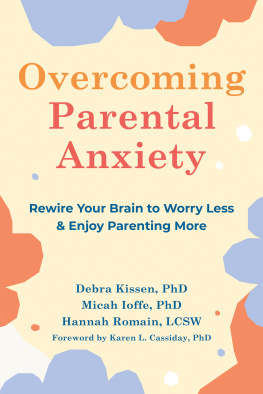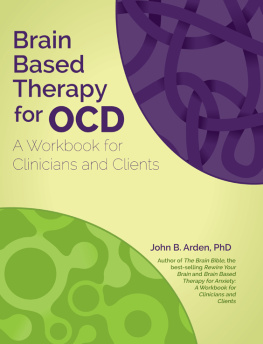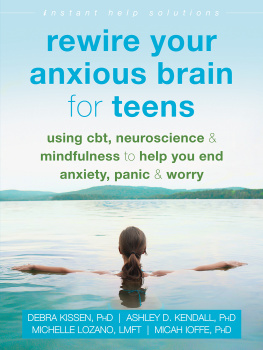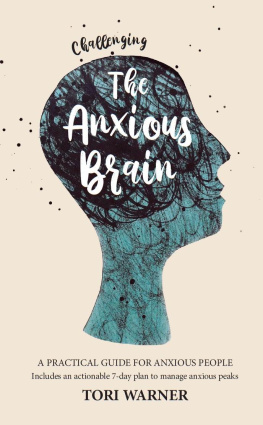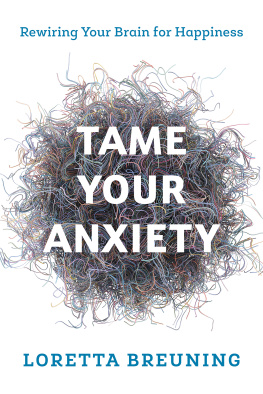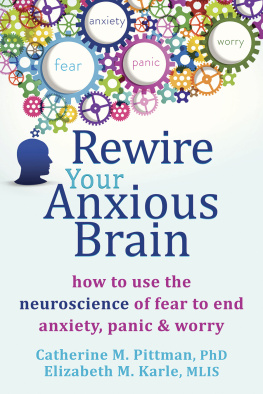BRAIN BASED THERAPY
FOR ANXIETY
A Workbook for Clinicians and Clients
J OHN B. A RDEN P H .D.
Author of The Brain Based Therapy for OCD:
A workbook for Clinicians and Clients
Copyright 2014 by John B. Arden Ph.D.
Published by
PESI Publishing & Media
PESI, Inc
3839 White Ave
Eau Claire, WI 54703
Printed in the United States of America
ISBN: 978-1-937661-81-6
All rights reserved. No part of this book may be reproduced or transmitted in any form or by any means, electronic or mechanical, including photo copying, recording, or by any information storage and retrieval system without the written permission from the author (except for the inclusion of brief quotations in a review).
Contents
Introduction
If you are plagued by anxiety, you are not alone. Anxiety disorders are more common in the United States than any other psychological problem, including depression. Some estimates indicate that one-fifth of all adults have experienced an anxiety disorder at some point in their lives.
We live in a stress-filled world. Terrorism, financial and job pressures, and the wars in Iraq and Afghanistan have all contributed to an underlying sense of anxiety in our day-to-day lives. Although most of us find ways to deal with that anxiety, some people experience it in the extreme and can, as a result, develop anxiety disorders.
Living with an anxiety disorder can be a challenge. It can make getting through the day and enjoying your life difficult. An anxiety disorder can put your life in disorder.
The good news is that you can bring your anxiety disorder under control. Just as your body has the ability to heal wounds, so can your brain. Your brain has the capacity to change through a process known as neuroplasticity, which means rewiring your brain.
This workbook will help you discover how to do just that. It contains the step-by-step lessons that I teach in my Mastering Anxiety class. Youll learn:
how anxiety develops
the types of anxiety
how your brain works and how to rewire it
what you can do to make your brain more capable of rewiring
which foods and nutritional supplements create the right biochemistry to help your brain make you calmer
how to restructure your thinking, so that you can make your anxiety work for you, instead of against you
how to avoid avoidance and maximize exposure (youll find out more about these in )
how to keep from overreacting to the physical sensations associated with anxiety
how to prevent relapse
In the following chapters, youll discover the practices that can help you overcome panic disorder, phobia, and generalized anxiety. These practices are what I call brain-based and evidence-based. Brain-based practices help you change how you think. Because your brain is central to everything you do and feel, when you rewire your brain, you can put anxiety behind you. Evidence-based practices are techniques that are known to help overcome anxiety. After performing hundreds of studies on treating anxiety disorders, psychologists have found that some techniques work and some do not. You are going to learn the ones that work. These evidence-based practices form the basis of two books I have written for professional therapists on brain-based therapy.
In this book, youll discover how to heal your anxiety from a biopsychosocial perspectivethat is, biologically, psychologically, and socially. A biopsychosocial approach is comprehensive because anxiety encompasses biological (your brain and the rest of your body), psychological (thinking and feeling), and social (social and cultural contexts) aspects. By following the practices in this book, you can physically change your brain and body, change the way you think to help you change the way you feel, and change the way you approach social situations. Youll learn how to rewire your brain and alter the way your body functions. Youll learn to restructure your thoughts, so that your emotions can follow their lead. Youll also learn to use the social world around you to enhance your comfort level.
You live in a social world with culturally defined methods of dealing with problems, including anxiety. Some of these are unhelpful and lead to misunderstandings. Youll learn which socially sanctioned methods to discard and which ones to embrace.
What this book will not cover is the use of medications to treat anxiety disorders. My position with respect to medication is that less is more. Although I am not fundamentally against the use of medications, I find that most people can heal their anxiety without them. Antianxiety medications, such as Ativan and Valium, can impede your ability to heal your anxiety in the long term and can contribute to a wide range of negative side effects, such as depression, sleep problems, and addiction. Selective Serotonin Reuptake Inhibitors (SSRIs), such as Paxil and Prozac, have been found to have anti-anxiety effects, but they also come with side effects. If you want your gains to be permanent, dont rely on medications. They are only useful when you use them. Try the methods described in this book before considering medications.
This book will also not cover post-traumatic stress disorder (PTSD) or obsessive-compulsive disorder (OCD). If you have PTSD or OCD, youll want to refer to one of my other books: Conquering Post-Traumatic Stress Disorder (with Dr. Victoria Beckner) and The Heal-Your-OCD Workbook (with Dr. Daniel Dal Corso).
Finally, this is not just a book about anxiety. It is a book on how to heal your anxiety. As you read through it, youll not only learn how to overcome excessive anxiety, but youll also be practicing methods to overcome it, through a series of exercises. With practice and the techniques you learn in the book, you, too, can live a life free of anxiety disorders.
Chapter 1
What Is Anxiety and What Causes it?
Everyone experiences anxiety once in a whilewhen the car breaks down on the way to a job interview, for example, or when youre standing on the high-diving board and the water looks a long way down. Anxiety is a fact of life. In fact, some anxiety is necessary. You need a little anxiety to get to work on time or to get to the grocery store before it closes. If you didnt have anxiety, you wouldnt know to get out of the way when you see a truck bearing down on you in the street.
Anxiety can be a bad thing, however, if you worry that your boss doesnt like you, even though you have no realistic evidence that he does not, or if you feel panic when there are too many people in the grocery store, or if you avoid crossing streets, because you never know when a truck is going to come out of nowhere. Anxiety becomes a problem when it gets turned on too high.
Feeling constant tension and worry makes each day trying at best and a walking nightmare at worst. And when youre extremely fearful about a situationmeeting new people, for instanceyour life becomes severely limited. You can feel like youre walking through a minefield when youre plagued by panic attacks, because you never know when one might occur. When anxiety becomes extreme, its considered an anxiety disorder. But an anxiety disorder doesnt have to be permanent.
How Jake and Tom Experience Anxiety
Next page

